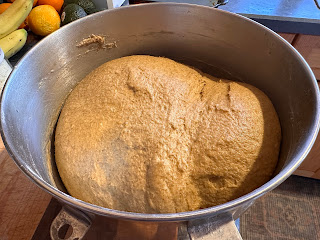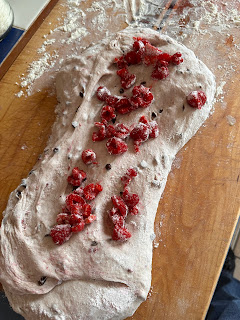Billings Breweries Bread Blog
My Blog List
Friday, April 25, 2025
105 Brewing Marbled Rye Bread
Friday, March 14, 2025
Montana Brewing - Espresso Porter Oatmeal Bread
March 14, 2025
Montana Brewing was the first brewery in Billings and has established itself as a go-to place for both food and beer in the center of downtown. I've been visiting the location from its earliest days and the beer has been a solid hit from the beginning and the quality has done nothing but improve over the years. I have eaten there a few times and the menu is quite extensive and never disappointing.
When it came time to do a bread based on one of their beers, I leaned toward their stout which has always been a good representation of the style and thought that an oatmeal bread might compliment it quite well. When I visited the brewery they happened to be out of the stout so I decided to sample the Espresso Porter and was VERY pleasantly surprised.
A porter is a cousin to the stout and, as it is historically brewed, tends to be harsher than its relative, something that I tend to appreciate. That said, this version is very smooth and has an almost creamy taste. If I didn't know better I'd think that it was served on nitro with its thick head. The coffee notes from the espresso were there but did not get in the way of the dark roasted malts. The brewer is to be complemented on the balance achieved in this beer.
As I was sipping it, I thought about the bread and still wanted to stay with the oatmeal approach. With the espresso and the oatmeal I figured that I had two common ingredients found at the breakfast table and knew I'd have a hit. I added molasses to the recipe to tame any residual hops that might remain but other than that, this might be the simplest recipe I've concocted in this series of brewery breads.
A side note: I started baking bread when I was in junior high school. My mother would bake bread on occasion and it was always a treat. I was very interested in cooking and hung out in the kitchen quite frequently, always enjoying looking through her cookbooks. I kept coming back to the "Yeast Bread" chapter of her mid-1950s Betty Crocker Cookbook and made my first of many forays into the baking world by trying my hand at the Oatmeal Molasses bread. It really turned out well and I thought of it as I was putting this recipe together.
Ingredients
2-3/4 cups (1 pound, 7 ounce) (670 grams) Montana Brewing Espresso Porter, at room temperature
1/4 cup (3.3 ounces) (42 grams) dark molasses
3 cups (10.3 ounces) (291 grams) old fashioned rolled oats
2 teaspoons kosher salt
2 teaspoons instant yeast
3 cups bread flour
2 cups additional bread flour
Yield: 20 loaves
Procedure
Place the beer, molasses, oats, salt, and yeast in a mixing bowl. Stir until mixed. Let stand for 5 minutes for the oats to absorb some of the liquid.
Add the 3 cups of flour and mix by hand or with a stand mixer until well-combined.
Add a cup of the additional flour and mix until it becomes thick enough to knead. Switch to the dough hook on the mixer or use an alternative kneading method described on the first page.
Knead until smooth and elastic, adding the additional flour as necessary. I used 5 cups of flour total when I made it.
After kneading is complete, give the dough a light spray of oil then cover the bowl with plastic wrap. Set aside to ferment until about doubled in size. I let mine go for about 2-1/2 hours.
When rising is compete, turn it out onto a floured board and flatten it out, pressing to remove the gas that built up. Divide the dough in two and shape into two loaves. Place these in oiled loaf pans, spay the tops with a little oil, cover with plastic wrap, and set aside to proof when they will about double in size..
Before proofing is done, preheat the over to 350 degrees F. I use a convection oven so you might try 375 in a traditional oven. Bake the bread for about 40 minutes. Check for doneness by removing the loaf from the pan and thumping the bottoms with your fingers. If it sounds hollow, it is done. Cool on a wire rack.
Illustrations

















































